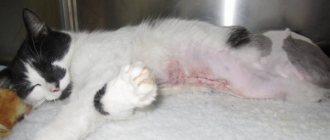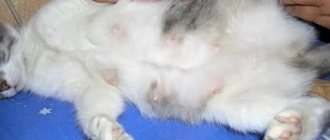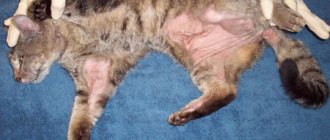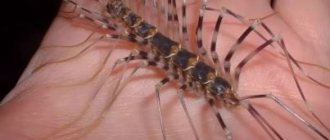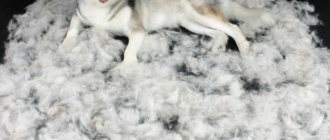The appearance of subcutaneous lumps on the body of a pet is an alarming sign that requires mandatory diagnosis. The wide variety of possible causes precludes any attempt at self-treatment. An incorrectly selected technique can harm the pet and worsen its well-being.
Despite the danger of possible consequences, do not panic. Many neoplasms are benign. For an accurate result, a thorough examination at a veterinary clinic will be required.
Causes of appearance and main types of neoplasms
There are 2 types of lumps or bumps on the body:
- Benign. They pose a danger only when they reach large sizes. In this case, adjacent tissues are infringed and nutrition and blood supply are disrupted. Metastases of the lump of benign etiology do not occur.
- Malignant. Tumors consisting of degenerated pathological cells prone to metastasis. If a cat’s lump is cancerous or large, there is very little chance for the pet to recover and recover.
Most often, the formation is benign in nature; the following types are distinguished:
Most often, this formation refers to a lipoma.
- Hematoma. If a cat has a blue-violet hue on its head, hips, under the eye or on its back that causes pain when pressed, most likely it is a hematoma or bruise. The formation is caused by an injury in which small vessels are damaged; sometimes such a lump can fester and develop into a cyst.
- Lipoma. The subcutaneous wen in a cat is formed from adipose tissue, when pressed it does not cause discomfort, sometimes it rolls around inside. If a small lipoma grows, it is better to remove it.
- Cavernous hemangioma. Red bumps on the stomach, side and even on the butt, which do not cause discomfort to the animal, represent vascular growth of benign etiology.
- Syringoepithelioma. It is a modified element of the sweat gland. Often such a lump appears on a cat’s stomach. The seal does not cause discomfort and does not grow.
Other types of cones, less common
The following neoplasms are often found in cats:
Older animals are more susceptible to melanoma.
- Abscess. Occurs on the thigh, elbow or face due to a bacterial infection on damaged skin. The lump may be blue and fester, causing the cat pain, fever, and fever.
- Cyst. Often formed as a result of blockage of the sebaceous glands, they can appear on any part of the body - on the forehead, near the neck, at the base of the tail, on the paw. The growth is not prone to malignant degeneration and is painless.
- Melanoma. Growths in the form of moles. Often they are black, dark blue, brown. Mostly appear in old animals.
- Mammary cancer. First, a compaction forms in the area of the gland of the same name. But then the tumors spread to the entire body. The lump can be black, purple, and often bleeds.
Sometimes a ball-like tumor on the neck, under the jaw, in the ear, on the outer side of the thigh, under the armpit or in the spine area is a tick that has embedded itself and grown to a large size. In such a situation, the parasite must be urgently removed, but it is important to do this correctly so that the insect elements remaining under the skin do not lead to suppuration and the formation of an abscess. A lump on the pad of a front or hind leg may be a manifestation of a common paw disease called coronitis.
Plain (solid, solid)
The monochrome uniform coloring of Scottish cats is considered classic by breeders. The solid or solid color of the animal implies the absolute exclusion of any inclusions, small marks and specks of a different color. The tone is rich, even along the entire length of the coat.
The most common used to be considered blue plain Scots. But today among the representatives of the breed there are many other variants of solid colors.
White
A Scottish cat with snow-white fur (without yellowness) looks luxurious. Possible eye colors are blue, amber, copper. According to the standard, eyes of different colors are allowed. The paw pads and nose are light pink.
Kittens may have markings of a different shade, which disappear after the first coat change. By the age of two, the coat of a white Scot should be crystal clear, without spots of a different color.
Black
The black cat has expressive yellow eyes. The nose and paw pads practically blend into the main color of the animal.
On the shiny bright coat of the Scottish beauty Ebony, 2-3 hairs of contrasting white color are allowed. The presence of large red or brown marks is not provided for by the standard.
Chocolate
The brown Scottish cat, also called chocolate, looks noble and impressive. The color of the coat contrasts with the animal's yellow, golden or copper eyes. The nose and paw pads are also dark brown.
Lilac (lavender)
The monochromatic lilac Scottish Fold has a gentle gray tint that smoothly turns into cream. The nose is slightly brownish, the paws on the bottom are the same color as the coat, in harmony with the main color of the pet. This lilac-lavender color goes well with eyes of copper, amber or orange shades.
Red (red)
Red or ginger color is a rare and valuable color of the Scots breed. The fiery edge is combined with burning amber irises. Pads and nose to match the dominant color.
The tail of kittens and adult animals is not very evenly colored. This deficiency does not disappear with age and is allowed by the standard. And the presence of marks on the head and limbs that remain after reaching the age of two are considered a deviation from the norm.
A red Scottish straight-eared cat can give birth to kittens not only with erect ears, but also with ears pressed to the head.
Cream
The cream or peach fold cat is infinitely elegant and beautiful. The delicate background of light fur, bright golden eyes and a pinkish nose give the pet an irresistible appearance. The pads on the paws are also pink. An animal with this color is similar to a red Scotsman, but its coat color is a shade lighter.
A peach fold kitten may have a blurry, fuzzy pattern on its paws and tail that does not disappear with age. This is not critical for a purebred pet, but leopard markings are absolutely unacceptable.
Faun (deer)
There is another unique color of Scottish fold cats with an interesting name - fawn, which means “young deer”. The nose and pads on the paws of these beauties are beige-pink.
Cinnamon
Cinnamon is a lighter and more delicate color than chocolate, but darker than red. The nose and paw pads of such animals are brown, beige or pink.
Blue color (blue)
The gray or blue Scottish cat has very beautiful amber eyes. The coat tone of a purebred pet can belong to any range of gray - from the lightest (blue) to completely dark (blue). At the same time, each hair is saturated and well colored, without streaks.
The nose and pads practically do not differ in color from the plain coat.
A gray Scottish Straight cat may be marked with a few streaks and drawings in childhood. But as they grow older, these color flaws go away.
Symptoms
During an oncological process in the body, the animal is often irritated.
If the bump on the head of a cat or kitten is benign, then it is soft to the touch, rolls under the skin, and does not hurt or bother you when pressed. Internal malignant growths often appear as capsules that can be normal temperature or hot. A lump on the withers, on the side of the neck or on the mucous membrane in the throat from degenerated cells quickly increases in size. In addition, an adult cat or kitten develops the following symptoms:
- weakness;
- irritability or lethargy;
- digestive problems;
- refusal to eat;
- sudden weight loss;
- dyspepsia.
Furuncle
This is not just an abscess - inflammation of the epithelium, but a disease (in acute or mild form) caused by decreased immunity and focal damage to the hair follicle. It is purulent and necrotic in nature, caused by white or aureus staphylococcus, and begins with a red tubercle:
Gradually, the sore increases, fills with pus, becomes painful, body temperature rises, apathy and loss of appetite are possible. The lesions affect some or all parts of the body, or isolated ones.
Under the skin, the pus is located, as it were, in a “vessel” that restrains the boundaries of inflammation, and after “ripening” one (or several) gray dots will be visible from above - the rod.
Do not squeeze out the boil! Otherwise, the pus will spill over the adjacent tissues.
The veterinary clinic will do everything you need, and in the case of a chronic form, they will prescribe antibiotics.
Keep a sick animal especially clean by placing disposable diapers on top of the bedding every day. Don't bathe! Trim the fur from the site of inflammation, apply ichthyol ointment or Vishnevsky, wipe with alcohol while changing the compress, give an anesthetic. In case of spontaneous opening of the sore, clean it as much as possible from pus (do not press!) and reapply a bandage with ointment, changing it every 4-6 hours until the wound is completely cleansed.
Diagnostic methods
If the owner notices that bumps have appeared on the neck of a cat or kitten, it is necessary to urgently take the animal to the veterinarian. The doctor will conduct an initial examination and ask the owner about the pet’s behavior and whether any changes have been observed in its habits. Sometimes palpation alone is not enough to determine an accurate diagnosis. Therefore, a number of additional diagnostic studies are prescribed. Often these are cytological and histological analyzes that help determine the internal composition of the neoplasm and its nature.
Prevention and hygiene of animal paws
Prevention and hygiene of cat paws plays an important role:
- If your pet is walking outside, it doesn’t hurt to inspect its paws from time to time. If they are dirty, wash them with warm water and baby soap.
- Cats should be given the opportunity to naturally grind down overgrown claws (using scratching posts). If this is not possible, overgrown claws are trimmed from time to time.
- The pet should be vaccinated in a timely manner and undergo a preventive veterinary examination at least once a quarter.
What to do to get rid of the tumor?
Enlarged formations are subject to mandatory removal.
If the lump on the nose, near the ear or neck is benign, stable and does not bother the animal, the veterinarian will advise simply observing it. Sometimes such tumors resolve on their own, without special treatment. The growths, which gradually grow and compress the surrounding tissues, are removed surgically using local anesthesia. To prevent infection in the postoperative period, a course of antibacterial therapy is required.
A common method for removing tumors of benign etiology is freezing with liquid nitrogen. This method is preferable for an old pet, because it will help minimize trauma.
If a cat has a lump on its neck that is malignant in nature, and the disease is diagnosed in a timely manner, surgical removal is prescribed, during which nearby tissues are also excised. This way, it will be possible to get rid of cancer cells and prevent relapse. Ancillary antitumor therapies such as chemotherapy and radiation are extremely rarely prescribed to cats. After surgery, a restorative treatment regimen is selected for the animal.
Treatment of cones in cats
If the neoplasm is benign and does not cause any concern to the animal, treatment may not be necessary. Sometimes surgery and other medical procedures can cause more harm than the lump itself.
We recommend the article: Why does a cat shed a lot?
If an abscess forms, it must be opened, all the pus drained, and the wound treated. Although the owner can do all this himself, it is better to contact a specialist. If even a little pus remains in the wound, or it is not treated correctly, the abscess will reappear. And in the worst case, blood poisoning can occur.
If the lump appears as a result of injury, you can apply cold to the sore spot. This will relieve inflammation. The animal may have to be given painkillers and anti-inflammatory drugs for the first time.
If the lump is caused by an infection, your doctor will prescribe antibiotics. If necessary, the veterinarian may additionally prescribe anti-inflammatory and supportive medications.
In case of a hernia, the internal organs are set back into place, and the animal is given a massage. In some cases, you have to resort to surgery.
When the paraanal glands become inflamed, it is necessary to remove all the fluid accumulated in them. You can give your animal painkillers and anti-inflammatory drugs.
For some types of atypical allergies, as well as for lymphadenitis, the doctor may prescribe hormonal medications. They do not have the best effect on the general condition of the cat’s body, which is why you should not give them to the animal on your own.
Malignant neoplasms are the most life-threatening for cats, but they can also be cured in the early stages. The lump will need to be removed. After this, a course of chemotherapy or radiation will begin. If help is provided in a timely manner, the cat has every chance of a full recovery. If the disease is detected in the final stages, the pet may have to be euthanized.
Complications
Sometimes such a formation can lead to an abscess in a pet.
If a tumor in the form of an abscess located under the skin bursts, there is a high probability that the pathological exudate will spread into deeper layers, which will ultimately lead to a severe abscess, often ending in the death of the animal. Therefore, if the skin is swollen and there is pus inside the tumor, you should not squeeze it out yourself. It is better to contact a veterinarian who will help get rid of the problem.
Things are much more complicated with malignant neoplasms. The fact is that degenerated cells grow rapidly, affecting surrounding tissues and lymph nodes. Soon they are separated from the main tumor and spread throughout the body through the bloodstream, affecting organs and systems. If a cat's cancer is diagnosed at a late stage, the chances of recovery are very low. To prevent the animal from suffering, the veterinarian will advise euthanizing it. Therefore, in order to avoid such sad consequences, it is necessary to immediately take the cat to the doctor if an incomprehensible neoplasm has formed under its skin on any part of the body.
Associated symptoms
Apart from the presence of a lump under the skin, the animal may not show any other symptoms. Wen and benign neoplasms, as a rule, do not manifest themselves in any way.
In some cases, the tumor constantly increases in size, as a result a large lump grows and begins to interfere with the cat and cause inconvenience. In such cases, measures should be taken as soon as possible.
Firstly, the rapid growth of a tumor is a dangerous sign. And secondly, the cat will try to get rid of the irritating factor by scratching or trying to rip off the bump in some way. This can lead to aggravation of the pathological process, injury, and bleeding from the damaged area.
In some cases, when a cat develops a gradually enlarging lump under the skin, a number of additional symptoms are observed. Suppuration or an inflammatory process may be accompanied by hyperemia of the affected area, skin tension, swelling and severe pain. Also, due to the activity of pathogenic microflora, symptoms of intoxication increase: fever, weakness, and sometimes nausea and vomiting.
Allergic reactions can be accompanied by extremely unpleasant itching sensations for the cat. Itchy skin provokes scratching, damage to the skin and aggravation of the problem.
Mastitis
It is a consequence of early weaning from a nursing mother, sometimes - diseases of the genital organs, damage to the nipples or false pregnancy.
The mammary glands become inflamed and swollen, become hard and hot, and the body temperature rises. This is what a Sphynx cat looks like:
If a nursing female is sick, milk may not be released or will come along with pus. The doctor, after the necessary tests, will make sure that there is no cancer and will prescribe treatment.
If the illness is mild, he will prescribe compresses and massages at home; if it is severe, he will prescribe medications, including antibiotics, or even surgery.
Abscess
This is a localized inflammation on the surface of the skin or deep in the tissues that can seriously threaten your pet's health if left untreated.
The most common causes are infection in wounds received by the cat in a variety of ways, which is why you can find swelling (with a purulent capsule inside) anywhere.
At this stage of edema and suppuration, urgent qualified help is needed, otherwise there is a risk of blood poisoning and death.
And we have all known prevention since childhood: immediately wash and disinfect any wounds that arise! How? Peroxide is better, others will cause a burn.
